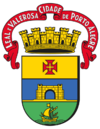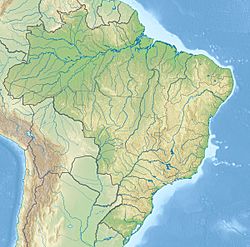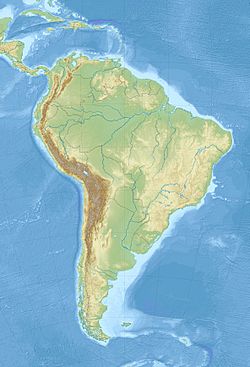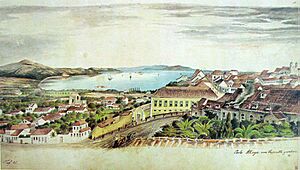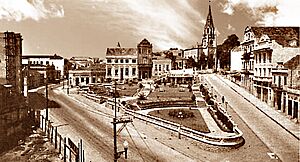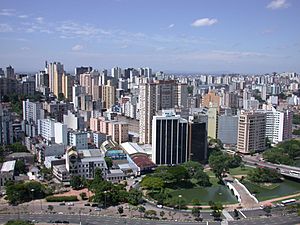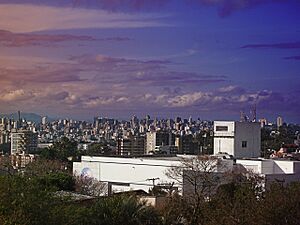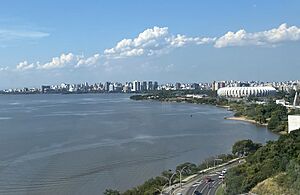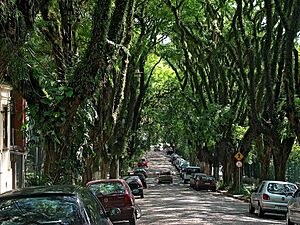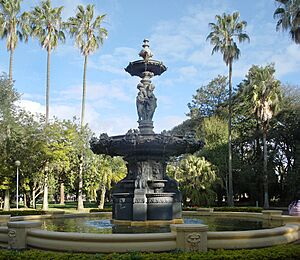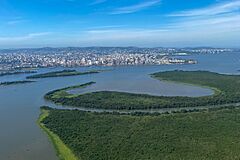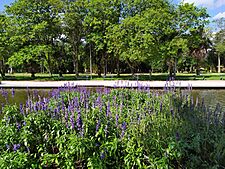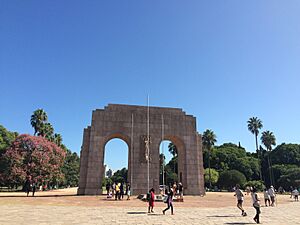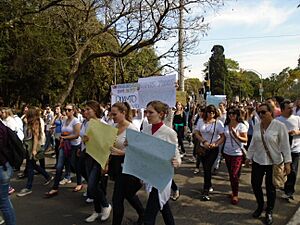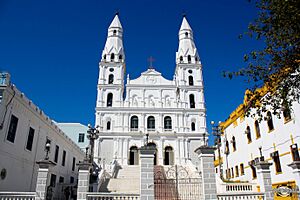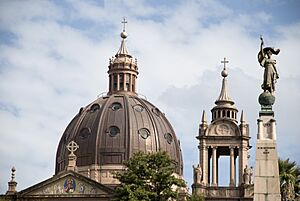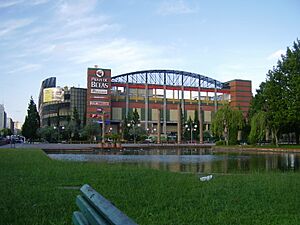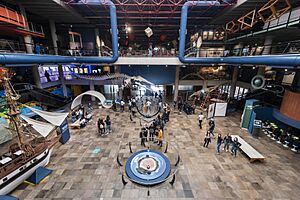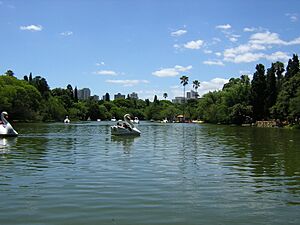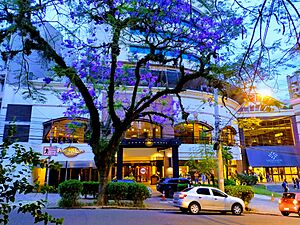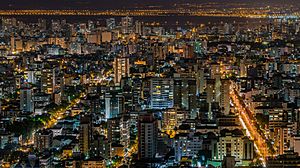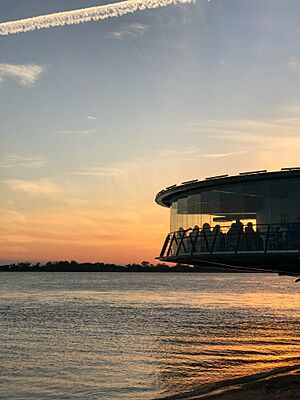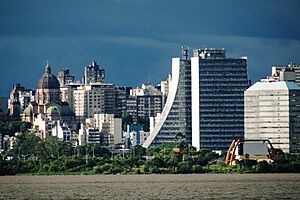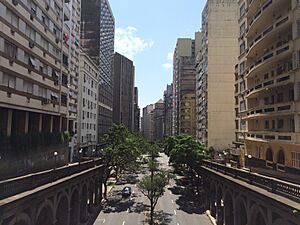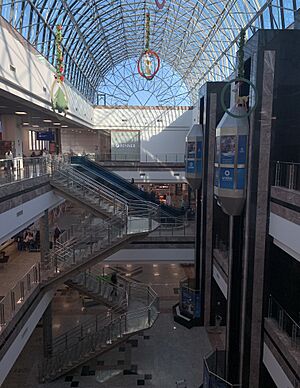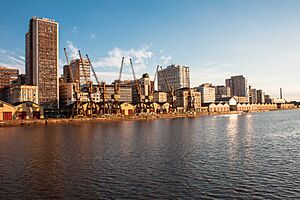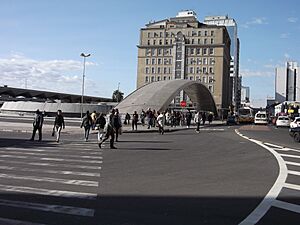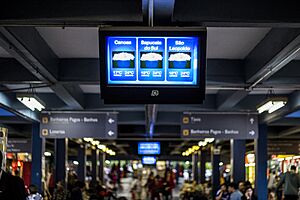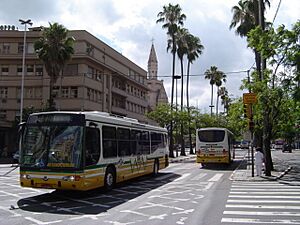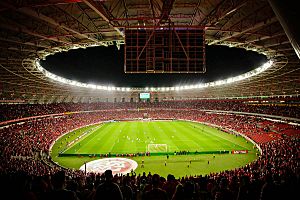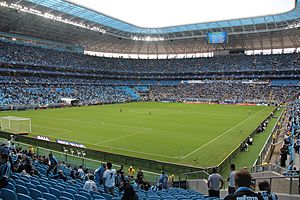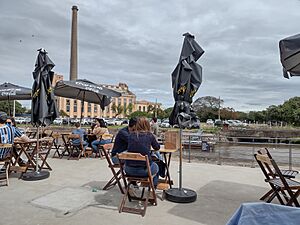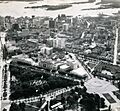Porto Alegre facts for kids
Quick facts for kids
Porto Alegre
|
|||
|---|---|---|---|
|
Municipality
|
|||
| Município de Porto Alegre Municipality of Porto Alegre |
|||
|
Skyline of Porto Alegre and Guaíba Lake
Mario Quintana House of Culture
Statue of Laçador
Gasometer Plant
Farroupilha Park
Monument to the Azoreans and Administrative Center
Iberê Camargo Foundation
Minor Basilica of Our Lady of Sorrows
|
|||
|
|||
| Motto(s):
Leal e Valorosa Cidade de Porto Alegre
Loyal and Valiant City of Porto Alegre |
|||
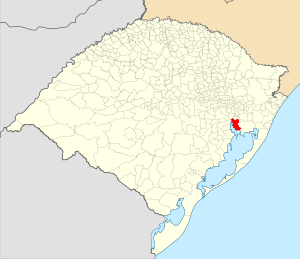 |
|||
| Country | |||
| Region | South | ||
| State | |||
| Mesoregion | Metropolitan Porto Alegre | ||
| Microregion | Microregion of Porto Alegre | ||
| Founded | 26 March 1772 | ||
| Area | |||
| • Municipality | 496.827 km2 (191.826 sq mi) | ||
| Elevation | 10 m (30 ft) | ||
| Population
(2022)
|
|||
| • Municipality | 1,332,845 (11th) | ||
| • Density | 2,837.5/km2 (7,349/sq mi) | ||
| • Metro | 4,405,769 (4th) | ||
| Demonym(s) | Porto-alegrenses | ||
| GDP (PPP, constant 2015 values) | |||
| • Year | 2023 | ||
| • Total | $77.7 billion | ||
| Time zone | UTC-3 (UTC−3) | ||
| Postal Code |
90000-000
|
||
| Area code(s) | +55 51 | ||
| HDI (2010) | 0.805 – very high | ||
Porto Alegre is a big city in Brazil. It is the capital of the state of Rio Grande do Sul. About 1.3 million people live here, making it one of Brazil's largest cities. It is also the center of a huge metropolitan area with 4.4 million people. Porto Alegre is the southernmost capital city in Brazil.
The city was officially founded on March 26, 1772. It was settled by immigrants from the Azores, islands that are part of Portugal.
Porto Alegre is located on the eastern side of Guaíba Lake. Five rivers meet here, forming a giant freshwater lagoon called Lagoa dos Patos. This makes Porto Alegre an important port and a major center for industry and trade in Brazil.
In recent years, Porto Alegre has hosted important global events. It was the first city to use participatory budgeting, which means citizens help decide how public money is spent. The city also hosted the World Social Forum several times. It is home to FISL, one of the world's largest free software events. Porto Alegre was also a host city for the 2014 FIFA World Cup and the 1950 FIFA World Cup.
Contents
- History of Porto Alegre
- About the City of Porto Alegre
- Geography of Porto Alegre
- People of Porto Alegre
- Economy of Porto Alegre
- Sustainability Programs
- Tourism and Recreation
- Education in Porto Alegre
- Culture of Porto Alegre
- Architecture of Porto Alegre
- Events and Festivals
- Transportation in Porto Alegre
- Sports in Porto Alegre
- Neighborhoods of Porto Alegre
- International Connections
- Images for kids
- See also
History of Porto Alegre
The official founding date for Porto Alegre is March 26, 1772. However, the first settlers arrived earlier, in 1752. These were 60 couples from the Azores, sent by Portugal. They first settled in a place called Porto de Viamão, which was the city's first name.
On July 24, 1773, Porto Alegre became the capital city of the province. In 1824, people from all over the world started to arrive. Many immigrants came from Germany, Italy, Spain, Poland, and the Middle East.
Porto Alegre is also known as the capital of the Pampas region. This area has wide plains and unique plants and animals. It is the home of the gaúcho, a brave warrior from the 16th century.
The 19th century was a time of important wars for the people of Porto Alegre. The Farrapos War began in Porto Alegre on September 20, 1835. This long war was fought for independence from the Brazilian Empire. The gaúcho became a legendary figure from this conflict.
After the war, the city continued to grow and change. Its port activities and shipyards became very important. Porto Alegre kept up with major cultural, political, and social changes happening in Brazil.
The city became famous worldwide in 1963 when it hosted the World University Games. In 1985, many people in Porto Alegre joined a movement for free elections. In 2024, the city experienced flooding due to heavy rain.
About the City of Porto Alegre
Porto Alegre sits on a delta where five rivers meet. This area is officially called Guaíba Lake. The city was settled in the mid-1700s by colonists from the Azores, sponsored by Portugal. It was officially established in 1742.
Porto Alegre is one of the richest and most diverse cities in Latin America. Its residents come from many backgrounds. These include indigenous Brazilians, Afro-Brazilians, and immigrants from Portugal, Russia, Germany, Italy, Spain, Ukraine, and Poland. There are also many Arab and Jewish people living here.
The city was once called Porto dos Casais (Port of the Couples). It was initially settled by Azoreans. Many families also came from Rio Grande, an important port city to the south. Porto Alegre is also known as "Porto do Sol" (Port of the Sun) and "Cidade Sorriso" (Smile City). More than 70 neighborhoods make up the city. Most people and businesses are in the Zona Norte (Northern Zone).
Porto Alegre hosted the World Social Forum in 2001, 2002, 2003, 2005, and 2010. It is a major industrial hub in southern Brazil. The city is also a center for gaúcho history and culture. It is famous for its churrasco (barbecue) and chimarrão (a strong, hot tea). In 2000, almost everyone in the city could read and write. Porto Alegre is known for its high quality of life.
Geography of Porto Alegre
Porto Alegre is at the northern end of a large coastal lagoon called Lagoa dos Patos. The city is on the east bank of the Rio Guaiba, which flows into this huge freshwater lagoon. The Jacuí River, Sinos River, Gravataí River, and Caí River also join the Guaíba near Porto Alegre.
The city has a long shoreline on Guaíba Lake and 40 hills. In the lake, many islands form an archipelago. This area has a special ecosystem with lots of wildlife. Porto Alegre's area has 28% of the native plants found in Rio Grande do Sul, with 9,288 species. Many of these are old trees from the Atlantic Forest. The animals are also diverse, especially on the islands and hills. Porto Alegre has many parks, squares, and tree-lined streets.
Climate and Weather in Porto Alegre
| Weather chart for Porto Alegre | |||||||||||||||||||||||||||||||||||||||||||||||
|---|---|---|---|---|---|---|---|---|---|---|---|---|---|---|---|---|---|---|---|---|---|---|---|---|---|---|---|---|---|---|---|---|---|---|---|---|---|---|---|---|---|---|---|---|---|---|---|
| J | F | M | A | M | J | J | A | S | O | N | D | ||||||||||||||||||||||||||||||||||||
|
110
31
21
|
107
30
21
|
92
29
20
|
107
26
17
|
119
22
13
|
141
20
11
|
141
19
10
|
117
21
11
|
142
22
13
|
138
25
15
|
111
27
17
|
100
30
19
|
||||||||||||||||||||||||||||||||||||
| temperatures in °C precipitation totals in mm |
|||||||||||||||||||||||||||||||||||||||||||||||
|
Imperial conversion
|
|||||||||||||||||||||||||||||||||||||||||||||||
Porto Alegre has a humid subtropical climate (Cfa). This means it has four clear seasons and rain throughout the year. Lake Guaíba makes the air more humid. Porto Alegre has the biggest temperature differences between seasons compared to other Brazilian capitals. This is because it is much further south. In December, there are 14 hours of daylight, and in June, there are 10 hours.
Winters are mild to cool, windy, and rainy. Temperatures usually range from 10°C to 19°C (50°F to 66°F). On the coldest days, it can drop below freezing. Summers are very hot, with temperatures often reaching 30°C (86°F) and sometimes 40°C (104°F). Summer rains can be uneven, with some dry periods. Fall is changeable, like winter, but warmer. Spring is usually very rainy with thunderstorms, strong winds, and hailstorms.
The El Niño weather pattern often causes floods in some neighborhoods, especially on the islands in Lake Guaiba. After a big flood in 1941, a drainage system and a wall were built to protect the city.
Snow is very rare in Porto Alegre. It has only snowed a few times in history, like in 1879, 1910, 1984, 1994, 2000, and 2006. However, frost can happen. Radiation fog is common, causing delays for early flights. Unlike cities further north, Porto Alegre gets more rain and clouds in winter. Summers are mostly hot and dry, but high humidity can make the air feel sticky.
The highest official temperature ever recorded was 40.7°C (105.3°F) on January 1, 1943. The lowest official temperature was -4.0°C (24.8°F) on July 11, 1918.
| Climate data for Porto Alegre (1991–2020, extremes 1949–present) | |||||||||||||
|---|---|---|---|---|---|---|---|---|---|---|---|---|---|
| Month | Jan | Feb | Mar | Apr | May | Jun | Jul | Aug | Sep | Oct | Nov | Dec | Year |
| Record high °C (°F) | 39.2 (102.6) |
39.0 (102.2) |
38.1 (100.6) |
36.0 (96.8) |
32.7 (90.9) |
31.6 (88.9) |
32.2 (90.0) |
34.9 (94.8) |
38.0 (100.4) |
38.2 (100.8) |
39.0 (102.2) |
40.3 (104.5) |
40.3 (104.5) |
| Mean daily maximum °C (°F) | 31.0 (87.8) |
30.5 (86.9) |
29.2 (84.6) |
26.4 (79.5) |
22.6 (72.7) |
20.3 (68.5) |
19.7 (67.5) |
21.8 (71.2) |
22.8 (73.0) |
25.2 (77.4) |
27.7 (81.9) |
30.0 (86.0) |
25.6 (78.1) |
| Daily mean °C (°F) | 25.0 (77.0) |
24.7 (76.5) |
23.5 (74.3) |
20.7 (69.3) |
17.2 (63.0) |
14.8 (58.6) |
14.1 (57.4) |
15.7 (60.3) |
17.2 (63.0) |
19.7 (67.5) |
21.7 (71.1) |
24.0 (75.2) |
19.9 (67.8) |
| Mean daily minimum °C (°F) | 20.7 (69.3) |
20.7 (69.3) |
19.5 (67.1) |
16.8 (62.2) |
13.5 (56.3) |
11.3 (52.3) |
10.4 (50.7) |
11.6 (52.9) |
13.3 (55.9) |
15.7 (60.3) |
17.2 (63.0) |
19.4 (66.9) |
15.8 (60.5) |
| Record low °C (°F) | 10.1 (50.2) |
11.9 (53.4) |
9.6 (49.3) |
4.5 (40.1) |
2.3 (36.1) |
−1.9 (28.6) |
−1.1 (30.0) |
−1.2 (29.8) |
2.2 (36.0) |
4.9 (40.8) |
6.7 (44.1) |
10.0 (50.0) |
−1.9 (28.6) |
| Average precipitation mm (inches) | 120.7 (4.75) |
110.8 (4.36) |
103.3 (4.07) |
114.4 (4.50) |
112.8 (4.44) |
130.4 (5.13) |
163.5 (6.44) |
120.1 (4.73) |
147.8 (5.82) |
153.2 (6.03) |
105.5 (4.15) |
115.7 (4.56) |
1,498.2 (58.98) |
| Average precipitation days (≥ 1 mm) | 9.1 | 9.1 | 8.6 | 8.5 | 8.1 | 8.8 | 9.2 | 8.9 | 9.5 | 9.9 | 7.9 | 8.7 | 106.3 |
| Average relative humidity (%) | 73.0 | 74.9 | 75.7 | 77.8 | 81.5 | 82.8 | 81.3 | 78.2 | 77.4 | 76.0 | 72.1 | 71.4 | 76.8 |
| Average dew point °C (°F) | 20.5 (68.9) |
20.6 (69.1) |
19.6 (67.3) |
17.3 (63.1) |
14.6 (58.3) |
12.4 (54.3) |
11.4 (52.5) |
12.5 (54.5) |
13.7 (56.7) |
16.0 (60.8) |
17.1 (62.8) |
19.2 (66.6) |
16.2 (61.2) |
| Mean monthly sunshine hours | 237.6 | 206.9 | 206.5 | 167.1 | 144.0 | 119.1 | 133.7 | 150.1 | 149.6 | 176.2 | 223.7 | 238.5 | 2,153 |
| Mean daily daylight hours | 13.8 | 13.1 | 12.2 | 11.4 | 10.6 | 10.2 | 10.4 | 11.1 | 11.9 | 12.8 | 13.6 | 14.1 | 12.1 |
| Average ultraviolet index | 6 | 6 | 6 | 5 | 4 | 4 | 4 | 5 | 5 | 5 | 6 | 7 | 5 |
| Source 1: Instituto Nacional de Meteorologia | |||||||||||||
| Source 2: NOAA Weather atlas(Daylight-UV) | |||||||||||||
Vegetation and Green Spaces
Porto Alegre is in a special area where subtropical forests meet the Southern Brazilian grasslands (pampa). Many programs work to protect the native trees. The city has lots of green spaces, making it one of the greenest capitals in Brazil.
The city has about 39 square kilometers (9,600 acres) of green space. This means there are about 17.6 square meters (190 sq ft) of green space for each person. Over one million trees line the streets. The city plants about 30,000 new trees every year.
There are two important environmental protection areas: the "Delta do Jacuí" (Jacuí Delta) State Park and the Lami Biological Reserve. The Lami José Lutzenberger Biological Reserve was created in 1975. It protects nature and helps with research and environmental education.
Water Systems
Most of the city (87.7%) has sewer service, and 100% of people get treated water. In Porto Alegre, the Municipal Department of Water and Sanitation Services (DMAE) provides water. It is the largest city-run water supplier in Brazil.
In 2010, the Inter-American Development Bank (IDB) provided money to improve water quality in Guaíba Lake and the Cavalhada River. This project also helps reduce flood risk and improves urban services. It aims to make life better for over 700,000 residents.
Air Quality
Cars and trucks are the main source of air pollution in Porto Alegre. The city has the second worst air quality in Brazil, after São Paulo. Using new buses on special bus lanes has helped reduce pollution. The city also encourages cleaner fuels and monitors pollution levels.
A group of organizations works together to monitor air quality. They use five air monitoring stations. Using a special fuel called city diesel has greatly reduced sulphur levels in the air. The city is also thinking about using hybrid buses that run on both diesel and electricity. Many taxis are switching from gasoline to natural gas.
People of Porto Alegre
Ethnic Groups
| Race and ethnicity in Porto Alegre | ||||
|---|---|---|---|---|
| Ethnicity | Percentage | |||
| White | 73.6% | |||
| Pardo (Multiracial) | 13.4% | |||
| Black | 12.6% | |||
| Amerindian | 0.2% | |||
| Asian | 0.2% | |||
In 2022, Porto Alegre had 1,332,845 people. Most residents (73.6%) are White. About 13.4% are Pardo (mixed-race), and 12.6% are Black. A small number are Amerindian (0.2%) or Asian (0.2%).
Porto Alegre's population is mostly of European descent. The city was first settled in the mid-1700s by Portuguese colonists from the Azores Islands. From 1748 to 1756, about 2,300 Azoreans were sent to the region. They were sent by the King of Portugal to protect Southern Brazil. These colonists, mostly married couples, founded the city called Porto dos Casais (Port of the Couples), which is now Porto Alegre.
Religion in Porto Alegre (2010) Catholic Church (63.85%) Protestantism (11.65%) Spiritism (7.03%) Umbanda and Candomblé (3.35%) Other religions (3.64%) Irreligious (10.38%)
The first non-Portuguese settlers were German immigrants. They arrived in 1824 but were sent to nearby São Leopoldo. Many German descendants later moved to Porto Alegre.
The second largest group of immigrants were the Italians. They started arriving in 1875, mostly from northern Italy. Like the Germans, they first settled in rural areas. Later, many moved to Porto Alegre. Other groups include people from Poland, Ukraine, the Middle East, Japan, and Spain. A genetic study from 2011 showed that Porto Alegre's population is about 77.70% European, 12.70% African, and 9.60% Native American.
Population Growth in Porto Alegre
- Changing demographics of the city of Porto Alegre

Source: Planet Barsa Ltda.
Religion in Porto Alegre
According to the 2010 census, most people in Porto Alegre are Roman Catholics (63.85%). Other religions include Protestants (11.65%), spiritists (7.03%), and followers of Umbanda and Candomblé (3.35%). About 10.38% of the population reported having no religion.
Economy of Porto Alegre
Porto Alegre is a major industrial and commercial center in Brazil. Its location where five rivers meet makes it an important port. Products like soybeans, leather, canned beef, and rice are shipped from Porto Alegre to places like Africa and Japan.
Many important businesses are based in Porto Alegre, such as Gerdau, Petroleo Ipiranga, Zaffari, and RBS. Large companies like General Motors (GM) and Dell Computers have plants in the nearby metropolitan area.
The city also has excellent hospitals, including Hospital Moinhos de Vento, Santa Casa de Misericordia Hospital, and Clinicas Hospital. These are considered among the best in Latin America. Shopping is also a big part of the economy, with many malls like Praia de Belas Shopping and Shopping Iguatemi.
Porto Alegre is home to the Electronics Technology Center (CEITEC). This center develops and produces special integrated circuits (ASICs). It was the first IC design center in Latin America. CEITEC helps grow the electronics industry in the region. The Brazilian government invested almost US$210 million in this project.
In 2006, the city's total economic output (GDP) was R$30,116,002,000. The average income per person in the city was R$20,900 in 2006.
Sustainability Programs
Energy Sources
Brazil mostly uses hydroelectric power. To reduce this dependence, there are plans to use more natural gas and other energy sources. A natural gas pipeline from Bolivia to Brazil was finished in 1999, ending in Porto Alegre.
The largest wind energy park in Brazil is being built near Porto Alegre in Osório. It will add 150 megawatts (MW) of power. This amount could meet two-thirds of Porto Alegre's energy demand. The wind farm opened in 2008 and is planning to expand to 300MW, which would make it the largest in the region.
Recycling Efforts
Porto Alegre was one of the first cities in Brazil to start a recycling program. It is known for having some of the best waste management practices in the country. The city produces about 1,600 tonnes of household waste every day. Since 1997, all waste that cannot be recycled goes to special landfill sites. These sites are designed to prevent pollution from leaking into the soil.
Tourism and Recreation
Porto Alegre offers many attractions for visitors. These include the Piratini Palace, which is the state government's main building, the Porto Alegre Botanical Garden, Moinhos de Vento Park, the Public Market, and Farroupilha Park.
Nightlife and Entertainment
Porto Alegre is famous in Brazil for its lively nightlife. The city has many clubs, pubs, bars, and restaurants to suit different tastes and budgets. You can find everything from traditional corner bars to all-night raves and nightclubs. The "SoHo" area has a block full of popular spots.
In the Cidade Baixa (Lower City) neighborhood, the historic João Alfredo street offers many options for dancing and fun, playing different types of music. Padre Chagas Street, known as Calçada da Fama, has more trendy bars. Goethe Avenue also has many bars and dance clubs.
Rua Fernando Gomes has many pubs, cafes, and bars. Avenida Osvaldo Aranha, near Farroupilha Park and the Federal University, has bars popular with young people. Moinhos de Vento is a wealthy neighborhood with fashionable bars and clubs that often play house music. You can find typical Irish pubs and cafes on Padre Chagas Street.
The Araujo Viana Auditorium, located near Oswaldo Aranha street in the Farroupilha Park, is a major venue for concerts, performances, and meetings. It was opened in 1964 and is an important place for cultural events.
Education in Porto Alegre

Porto Alegre has several important educational institutions. These include the Universidade Federal de Ciências da Saúde de Porto Alegre (UFCSPA), the Universidade Federal do Rio Grande do Sul (UFRGS), and the Pontifical Catholic University of Rio Grande do Sul (PUCRS).
University System
The Federal University of Health Sciences of Porto Alegre (UFCSPA), the Federal University of Rio Grande do Sul (UFRGS), and the Pontifical Catholic University of Rio Grande do Sul (PUCRS) are all highly ranked universities in Brazil and Latin America. UFRGS is also one of the top three universities in Brazil for post-graduation studies.
PUCRS has a large scientific and technological park called TECNOPUC. This park connects graduate courses, research, and innovation. PUCRS is also known for its excellent programs in air transport and pilot training. Other important universities in the area include the Lutheran University of Brazil (ULBRA) and UNISINOS.
Culture of Porto Alegre
Museums to Explore

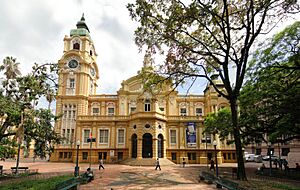
Rio Grande do Sul Museum of Art (MARGS)
This building has an eclectic style and was designed by German architect Theo Wiederspahn. It used to be a government office. Today, it holds the largest public collection of art in Rio Grande do Sul.
Júlio de Castilhos Museum
Founded in 1903, this is the oldest museum in the state. It has thousands of items related to local history. You can see Indian relics, objects from the Ragamuffin War and the Paraguayan War, and sculptures from the Jesuit Reductions.
Joaquim Felizardo Museum
This museum has a large collection of old artifacts and photos of Porto Alegre. Its historic building, from 1845 to 1855, is one of the few remaining examples of colonial architecture in the modern city.
Rio Grande do Sul Memorial This museum shows a huge collection of documents, maps, and other items about the state's history. Its building, also designed by Theodor Wiederspahn, is a beautiful example of eclectic architecture.
Iberê Camargo Foundation The Iberê Camargo Foundation is a famous building in southern Porto Alegre. It displays the art of local artist Iberê Camargo. It also hosts changing art exhibitions. The building, designed by Portuguese architect Álvaro Siza, opened in 2008 and offers views of the Guaiba river.
Luiz Carlos Prestes' Memorial Designed by Oscar Niemeyer, the Luiz Carlos Prestes' Memorial is a newer cultural spot. It tells the story of Prestes' life and has a hall for cultural, social, and political events.
Carnival Celebrations
The Porto Alegre Carnival started in the 18th century. People would throw flour, water, and "limão de cheiro" (scented lemons) at each other. Later, Carnival associations formed, and their rivalry shaped the city's celebrations. The corso, a parade of floats, was enjoyed by wealthier residents.
A key figure in Carnival is King Momo. He receives the keys to the city from the Mayor of Porto Alegre. This means he symbolically rules the Carnival for four days of fun and celebration.
Classic Music Scene
Porto Alegre is a major center for classical music in the state. It has a large audience for this type of music. International performers often include Porto Alegre on their tours. The city has two main orchestras: the Porto Alegre Symphony Orchestra (OSPA) and the PUCRS Philharmonic Orchestra. There is also the São Pedro Theater Chamber Orchestra and many smaller music groups.
The UFRGS has strong music programs. They conduct research, train music professionals, and organize high-quality public concerts.
Local Cuisine
The traditional drink in Porto Alegre is chimarrão. It is a strong, hot tea made from erva mate. The Chalet of the XV de Novembro Plaza is a very old and traditional bar and restaurant. It is one of the few places where "lambe-lambes" still work. These are photographers who develop pictures outdoors using old methods. The Chalet building is over 100 years old and has a Bavarian style with original chandeliers.
Architecture of Porto Alegre
The buildings in Porto Alegre mix old and new styles. This is most clear in the city center, the historic urban center. Here, you can see 18th-century buildings next to 19th-century and modern ones.
Porto Alegre's architecture has changed over time. It started with the Portuguese colonial style. Then came neoclassical, eclectic, and modernist styles. The city grew taller and wider, merging with nearby towns to become a metropolis.
Today, new buildings are being built with postmodernism and globalization influences. This creates a mix of styles. Some people worry that this changes the city's unique identity and destroys important historic buildings.
The city is currently working on big construction projects, especially for roads. It is also building important examples of contemporary architecture. Porto Alegre faces challenges as it grows, with some people still living in slums without basic services. There is also debate about how the city is planning its growth, housing, and nature preservation.
Events and Festivals

Porto Alegre hosts many cultural events throughout the year.
- World Social Forum: This event has been held in Porto Alegre several times (2001, 2002, 2003, 2005). It brings together over 100,000 people from more than 100 countries. The main goal is to discuss and solve social issues.
- Porto Verão Alegre: During the summer, the "Porto Summer Alegre" takes place. This celebration includes many performances and exhibitions. In 2005, about seventy plays were performed.
- International Free Software Forum (FISL): This event promotes and supports free software. It is sponsored by a Brazilian non-profit organization.
- Farroupilha Week: This cultural celebration happens in mid-September. It includes parades, food, and music. The "Acampamento Farroupilha" is set up in Harmonia Park, where thousands of people camp and eat traditional food to remember the Farroupilha Revolution.
- Bookfair: Held every November at Alfândega Square. In October, Porto Alegre hosts one of the largest Book Fairs in the Americas. This event has been happening since 1955, attracting about 2,000,000 people each year.
- Worldwide Pinhole Photography: This is an international event that celebrates pinhole photography. It takes place every year on the last Sunday in April.
- Mercosur Biennial Exhibition: This important art and cultural event is held in Porto Alegre every two years between October and December. It attracts many visitors.
- Carnival: Like other Brazilian cities, Porto Alegre has big celebrations before Lent. There is a Escola de Samba contest with many groups competing.
Transportation in Porto Alegre
International Airport
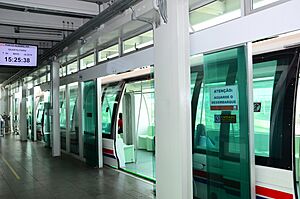
Salgado Filho International Airport serves flights to most major cities in Brazil. It also has international flights to other South American countries, Panama, and Portugal.
Port Facilities
The Port of Porto Alegre is on the eastern side of Guaíba Lake. It is one of Brazil's largest ports. Its location allows for constant shipping traffic between Porto Alegre and Buenos Aires. It transports steel products and farm goods.
Metro System
Porto Alegre has a rapid transit system called Trensurb. It connects downtown Porto Alegre to northern neighborhoods and nearby cities like Canoas and Novo Hamburgo. The line has stations at important places like the Public Market, the bus station, and the airport.
Trensurb is run by the federal government, the state government, and the city of Porto Alegre. It has 22 stations and is about 43 kilometers (27 miles) long. About 130,000 people use it every day. The first part of the metro opened on March 2, 1985. There are plans for a metro system only within Porto Alegre, but construction has not started yet.
Highways Connecting the City
Porto Alegre is served by two federal highways, BR-290 and BR-116. BR-290 runs east–west across the state. It connects the coast to the BR-101 highway, which leads to northern Brazil. BR-116 runs north–south, linking Porto Alegre to other cities in Brazil and to Uruguay.
A third road, BR-448, is being built. It will connect northeast Porto Alegre to Sapucaia do Sul, offering an alternative to the busy BR-116.
Bus Services
The city has a good public transportation system, especially its autobuses. Porto Alegre also has mini-buses that go to all main neighborhoods. These offer sitting-only transport and allow you to get on and off anywhere, but they cost more. The Linha Turística (Tourist Line) is a bus that takes visitors on a 90-minute tour of the city's districts.
The city has special bus lanes to help reduce traffic. The bus fleet has 1,600 buses, including 150 mini-buses. About 325 million people use the bus system every year.
Transversal lines (like T1, T2) connect different neighborhoods without going through downtown. This helps people avoid changing buses for common trips. Circular lines (like C1, C2) run in a circle, usually connecting parts of downtown to nearby neighborhoods.
The main bus station downtown connects to national and international bus lines. It is also linked to a Trensurb station and city bus lines.
Taxi Services
Porto Alegre has 3,922 authorized taxis. Regular taxis are red, and airport taxis are white. Both have blue stripes with white lettering on the sides.
Sports in Porto Alegre
Football (soccer) is a huge passion in Porto Alegre. There is a big rivalry between two football clubs: Grêmio Foot-Ball Porto Alegrense, founded in 1903, and Sport Club Internacional, founded in 1909. Both teams play in Brazil's top league, the Campeonato Brasileiro Série A.
Both Grêmio and Internacional have won national and international titles. These include the South American top honor, the Copa Libertadores, and the highest global trophy for football clubs, the Club World Cup. The rivalry between them is called the Grenal. It is known as one of the most intense rivalries in Brazil, South America, and the world. Other local teams include Esporte Clube São José and Esporte Clube Cruzeiro.
Porto Alegre was one of the host cities for the 2014 FIFA World Cup. The Beira-Rio Stadium, home of SC Internacional, was updated for the World Cup and can hold 56,000 fans. Internacional's old stadium, the Estádio dos Eucaliptos, was used for the 1950 FIFA World Cup. Grêmio plays in their own stadium, the Arena do Grêmio, which opened in 2012. It can hold 60,540 spectators.
American football is also played in the city. There are two teams: Porto Alegre Pumpkins and Porto Alegre Bulls.
On January 22, 2015, Porto Alegre hosted its first Ultimate Fighting Championship (UFC) event. It was called UFC Fight Night: Bigfoot vs. Mir. Former UFC Heavyweight Champion Fabrício Werdum is from Porto Alegre.
Neighborhoods of Porto Alegre
Porto Alegre is divided into Neighborhoods. There are 81 official neighborhoods. While these areas do not have their own administrative powers, many neighborhood associations work to improve their local areas.
International Connections
Twin Towns – Sister Cities
Porto Alegre has special connections with other cities around the world. These are called twin towns or sister cities:
Partner Cities
Porto Alegre also has one partner city:
 Paris, France (2001)
Paris, France (2001)
Images for kids
See also
 In Spanish: Porto Alegre para niños
In Spanish: Porto Alegre para niños











